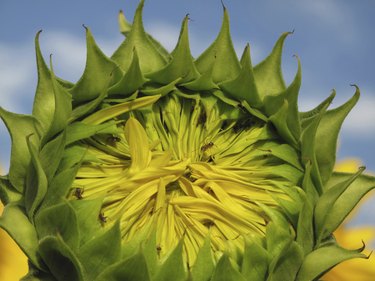
Like Jack clambering up the beanstalk, ants ascend sunflowers (Helianthus spp.) in search of treasure. Some ants on sunflowers climb such dizzying heights to collect nectar from small pores at the bases of the leaves. Others follow in the footsteps of tiny, sap-sucking insects that drench the plants in sweet, gooey excrement. Nectar-drinking ants help the sunflowers, but excrement-collecting ones often contribute to their decline.
Deciding which ones a sunflower hosts is essential for determining whether they should stay or go. Depending on the species, sunflowers may grow as annuals or perennial varieties in U.S. Department of Agriculture plant hardiness zones 6 through 9
Video of the Day
Video of the Day
Extrafloral Nectaries and Sunflower Sap
Many sunflowers, whether annuals or one of the many perennial varieties, have nectar-secreting pores protruding from the bases of their tender new leaves. Called extrafloral nectaries, these pores attract ants even before the sunflowers bloom.
In repayment for this bounty, the ants also feed on fungal spores or drive off leaf-chewing caterpillars or insects. Sunflowers less stressed from predator damage have more energy to devote to flower and seed production.
Sunflowers and Aphids
Colonies of aphids — most of them pregnant females — attach themselves to a sunflower's stalks and the backs of its leaves. They insert their sharp, tubular mouths into the plants and drain their nutritious sap. In small numbers, they do little damage. but as their populations increase, the leaves may twist and yellow, eventually drying up and falling off.
As sucking insects, aphids require lots of sap to meet their nitrogen requirements. After metabolizing the nitrogen, they excrete the leftovers as sticky, sweet honeydew. Honeydew attracts sooty mold that forms patches of greasy black fungus. It also attracts ants.
Honeydew and Little Black Ants
Little black ants (Monomoriuim minimum) approach honeydew-laden sunflowers with the enthusiasm of junior campers at a marshmallow roast. To make sure everyone gets in on the act, the ants mark the trails between their nests and the plants with scented pheromones.
Although not the only ants to feed on honeydew, little black ants are the most protective ones. When competition approaches, they raise and wave their hind ends in unison, releasing toxic chemicals to drive the enemies away. They also have tiny stingers to battle other ants and aphid predators, such as lacewings, ladybugs and predatory wasps.
Ant Management Options
If a close inspection reveals the ants drinking from the tiny, raised nectaries at the bases of the leaf stalks, let them be. If they're stroking the aphids' abdomens and collecting the excreted honeydew, it's time for action and to decide how to keep ants off sunflowers.
First, set the hose spray attachment to sharp spray and rinse the infested plants. Spray them thoroughly, hitting the backs of all the leaves and the entire stalks. The dislodged aphids are unlikely to recover. Check the plants daily for the next week and rinse as new aphids appear.
In the meantime, line the ants' scent trails with slow-acting, enclosed bait traps formulated for sugar-loving ants. Boric acid is toxic enough to kill them without seriously threatening children or pets, but don't use more bait than necessary, and conceal it as well as possible. The ants carry the bait back to their nests, where the colonies share the food and die out over several days. Leave it in place until the streams of ants disappear.